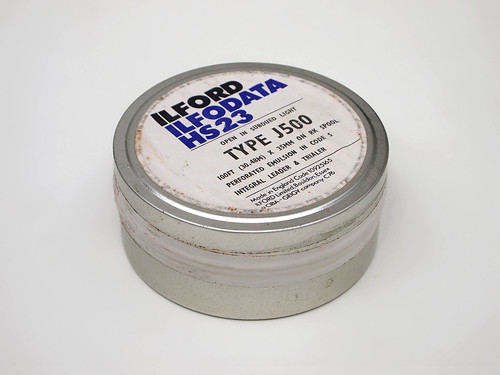 |
| Ilford Ilfodata HS23 Type J500 document film |
This tin of bulk film was a speculative buy from a well known auction site, specifically because I'd never heard of the film before. The only reference to the film I've found online is
Viewfinder from June 1979,
Ilford's in house magazine; indeed typing "
Ilford Ilfodata HS23 Type J500" into Google returns just that one result. The underside of the tin has a label with the code "SZ 79 C" - possibly
meaning it was manufactured in Swizterland in 1979 by Ciba (who bought out Ilford in 1969) although the label on the front of the tin does state "Made in England". The film is referred to on page 4, in an article headed 'Ilford in Microrecording'. It's worth quoting at length:
The ever-expanding range of ILFORD microrecording films ensures that the right product exists for the majority of applications. Where business documents, continuous stationery, cheques, statements or invoices are to be microfilmed, one of the ILFODATA High Speed films is particularly recommended.
- HS 22 2.5/1000 polyester base dye resin backing.
- HS 23 5/1000 acetate base dye resin backing.
- HS 24 5/1000 acetate base carbon resin backing.
These products offer the combination of fine grain, high speed, high resolving power and - because of their panchromatic sensitivity - are recommended for accurate recording of multicoloured originals.
The article then goes on to mention Ilfodata HR31 specifically having an anti-halation underlayer, so I assume that the other films do not, although they have the backing as described. After loading a length of film into a canister to use, the colour of the backing was quite noticeable, being a deep, intense, almost ultramarine blue.
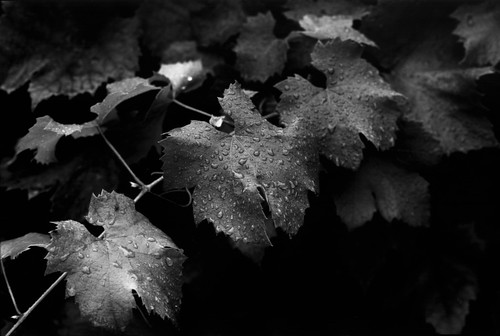 |
| Vine Leaves, Ilfodata HS23 |
I shot two rolls of the film using my
Olympus OM10. For the first roll I didn't accurately meter the shots I took: on the film canister I did note "last grapes 1000th at f5.6", but I may have meant 'eucalyptus' as that was the last series of shots on the roll. I stand developed the film with Rodinal diluted 1:100. The results were mixed: many frames were barely legible; those that were are clearly high contrast as one would expect from a document film. The film itself has a very clear base, with no markings in the film rebates and in the frames I scanned the grain is as good as indiscernible. In the image below the bright sky appears to have a 'glowing' effect, which may be a result of the absence of an
anti-halation layer.
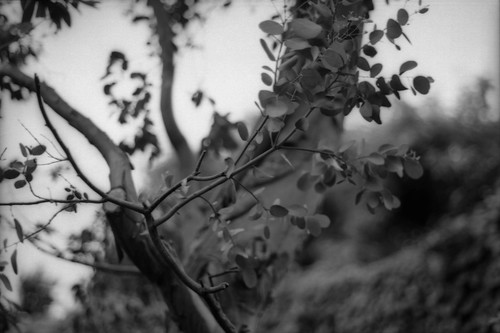 |
| Eucalyptus, Ilfodata HS23 |
I shot a second roll less impulsively, exposing five frames successively with the camera's film speed dial set at 25, 50, 100, 200, and 400 in an attempt to work out an ISO setting for the film. Using Rodinal diluted 1:100, I stand-developed the film for 1 hour. The results on the contact sheet shown below indicate clearly that an exposure index of either 25 or 50 gives a usable result: the highlight areas are becoming blocked on the top row of 25 EI; some shots in the second row of 50 EI show very little detail in the deeper shadows. The
Viewfinder quote about the film describes it as 'high speed' which, like the
Kodak Technical Pan film in my previous post (which can be used at 200 EI), may refer to its use as a document film; using the film for pictorial purposes would indicate a much lower EI setting. Possible directions for further tests might be to use a lower exposure index and to dilute the film developer even further to lower the contrast.
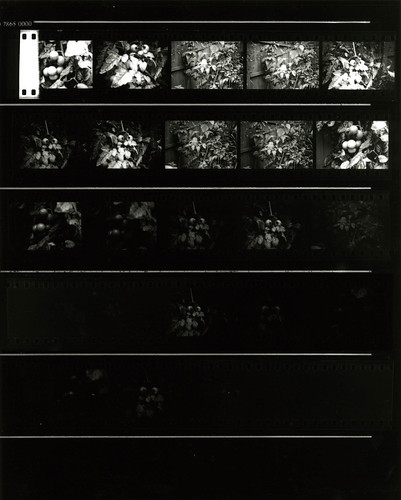 |
| Second test roll contact sheet of Ilfodata HS23 |
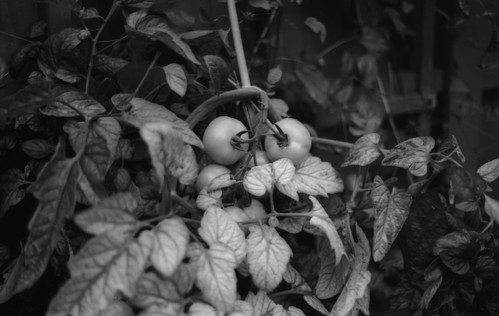 |
| Tomatoes, Ilfodata HS23, exposed at 25 EI |
 |
| Tomatoes, Ilfodata HS23, exposed 50 EI |
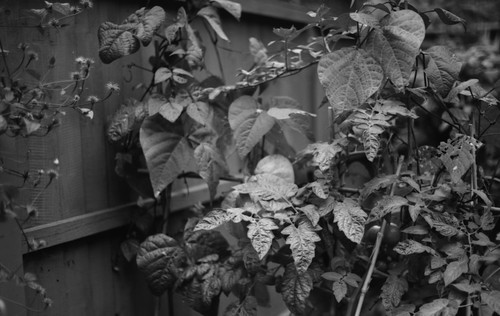 |
| Climbing Beans/Tomatoes/Clematis, Ilfodata HS 23, exposed 25 EI |
 |
| Climbing Beans/Tomatoes/Clematis, Ilfodata HS 23, exposed 50 EI |
Sources
Viewfinder, June 1979 (PDF file)








No comments:
Post a Comment